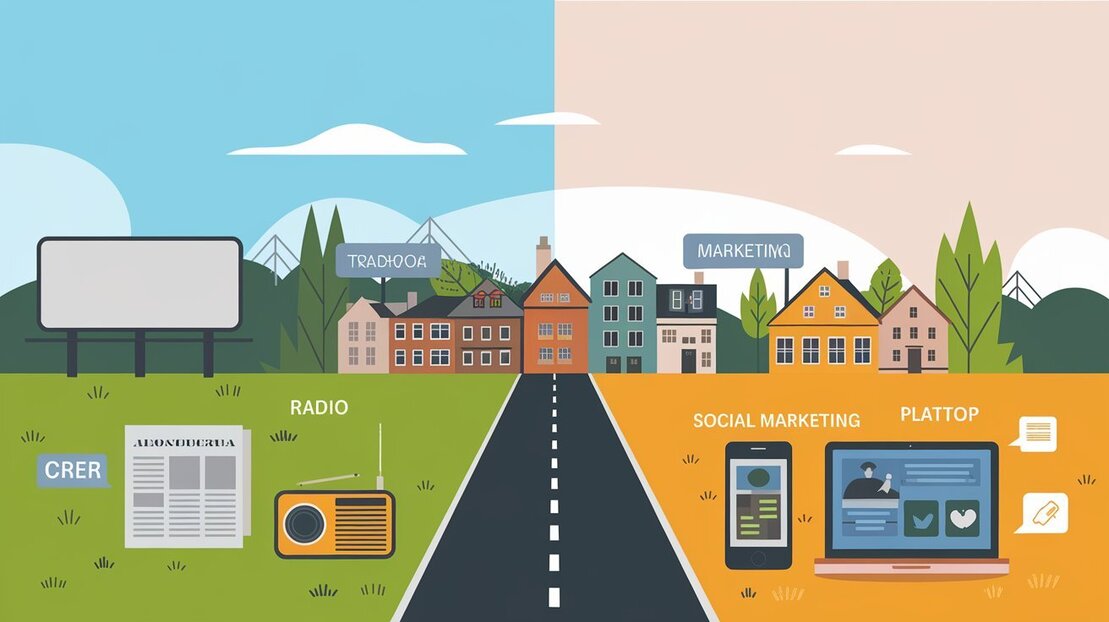Introduction
Marketing has always been the backbone of business growth, but the methods have drastically evolved over the years. In today’s fast-paced digital world, businesses face a critical decision: Traditional Marketing vs Digital Marketing. While traditional marketing methods like TV ads, billboards, and print media have their place, digital marketing has emerged as the future. This article explores why digital marketing is the superior choice for modern businesses, ensuring higher reach, better engagement, and measurable results.

What is Traditional Marketing?
Traditional marketing refers to conventional advertising methods that businesses have relied on for decades. It includes:
Print ads (newspapers, magazines, brochures)
Television and radio commercials
Billboards and outdoor advertising
Direct mail (flyers, catalogs, postcards)
Telemarketing
While traditional marketing is still in use, its effectiveness has declined due to the rise of digital alternatives and changing consumer behavior.
What is Digital Marketing?
Digital marketing encompasses all online strategies used to promote a business. This includes:
Search Engine Optimization (SEO)
Social Media Marketing (SMM)
Content Marketing
Pay-Per-Click Advertising (PPC)
Email Marketing
Affiliate Marketing
Unlike traditional methods, digital marketing allows businesses to engage with their audience in real-time, track performance, and optimize strategies for better results.
Traditional Marketing vs Digital Marketing: Key Differences
1. Cost-Effectiveness
Traditional marketing requires a significant budget for TV commercials, billboards, and print media.
Digital marketing is cost-effective, offering affordable options like social media ads and SEO to reach a larger audience with minimal investment.
2. Audience Targeting
Traditional marketing casts a wide net, often reaching people outside the target audience.
Digital marketing allows precise targeting based on demographics, interests, location, and behavior, ensuring better conversion rates.
3. Measurability & Analytics
Traditional marketing provides limited data on campaign performance.
Digital marketing offers in-depth analytics through tools like Google Analytics, allowing businesses to track ROI, user engagement, and campaign effectiveness.
4. Consumer Engagement
Traditional marketing is a one-way communication method with no direct interaction.
Digital marketing enables two-way communication, allowing brands to engage with their audience through social media, emails, and chatbots.
5. Global Reach & Scalability
Traditional marketing is often limited to a specific region or country.
Digital marketing allows businesses to reach a global audience instantly, with the ability to scale campaigns as needed.
Why Digital Marketing is the Future of Business Growth
1. The Shift in Consumer Behavior
With the increasing use of smartphones and the internet, consumers now prefer digital channels for shopping, entertainment, and communication. A well-executed digital marketing strategy ensures that businesses stay relevant in this changing landscape.
2. Higher ROI and Better Conversion Rates
Digital marketing offers better returns on investment (ROI) compared to traditional methods. Tactics like email marketing and PPC ads generate high-quality leads, increasing conversion rates.
3. Personalization and Automation
Digital marketing allows personalized communication through automation tools, improving customer relationships and brand loyalty.
4. Adaptability and Innovation
Unlike traditional marketing, digital marketing strategies can be quickly adjusted based on performance data, keeping businesses ahead of their competition.
Conclusion: The Winning Strategy
When comparing Traditional Marketing vs Digital Marketing, it is clear that digital marketing offers numerous advantages. It is cost-effective, highly targeted, measurable, and adaptable. While traditional marketing still has a role, businesses looking to grow in today’s digital world must prioritize online strategies. By investing in digital marketing, businesses can maximize their reach, engage with their audience, and drive long-term success.


